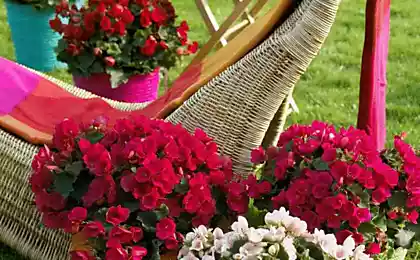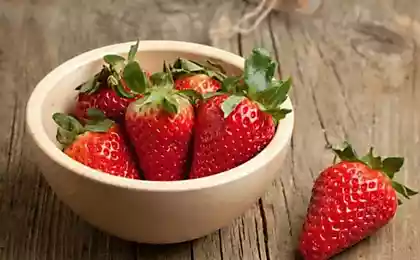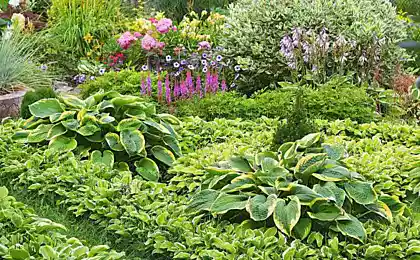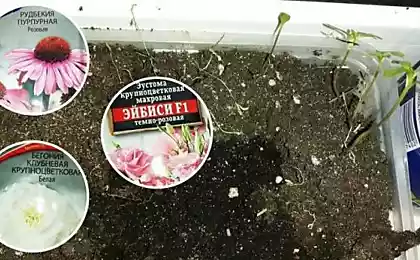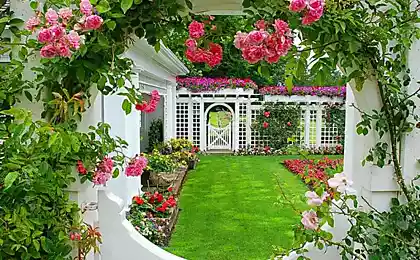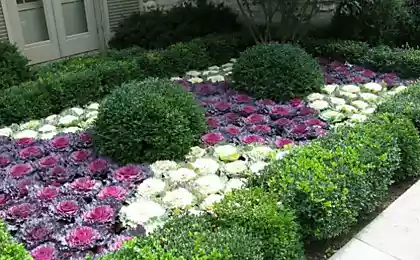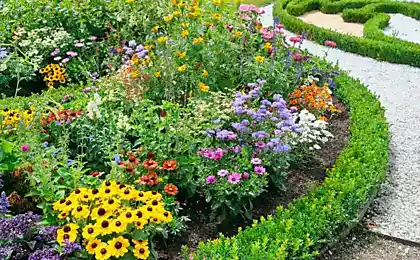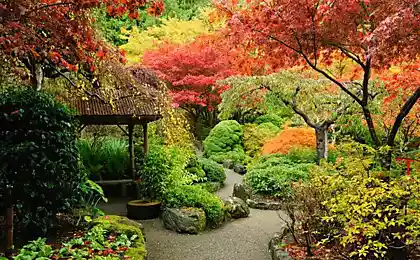498
Begonia Vale of eternal blossoms in your garden — growing and care
The Begonia family consists of almost a thousand species, among which there are rooms, and garden varieties. I love begonias because they are fairly undemanding, although belong to the thermophilic plants.
Begonia Vale of eternal blossoms one of the most undemanding species and can be grown as on the windowsill and in the garden. And named it the Vale of eternal blossoms due to continue flowering profusely, and in the garden is flowering lasts until the onset of cold weather.
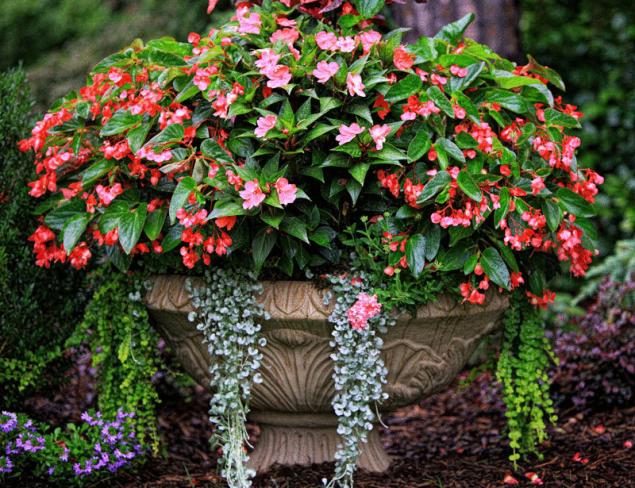
Description of the plant
Vale of eternal blossoms begonia is a low compact plant with a height of only 15 to 20 cm. the plant has succulent fleshy stems and large rounded leaves extended, devoid of symmetry. Leaf color may be different from light green to red-brown.
The flowers of this plant, not as attractive as the leaves, they are quite small and are assembled in branched inflorescences. Their color can be quite varied, there are plants with white, pink, red, purple, orange and bright crimson flowers. Extremely ornamental flowering begonias are planted in the garden they resemble a speckled and colorful carpet that is pleasing to the eye to the cold weather.
Seeds from the Vale of eternal blossoms begonias are quite small, usually brown.
Where and how to use
Quite often you can find the Vale of eternal blossoms begonia flower beds, it is planted as in group plantings, and a continuous carpet of using plants with different color leaves and flowers.
In addition, this type of begonias can be planted in outdoor pots or in pots on the balcony and the room.
In group plantings begonias are planted in the foreground, because of her short stature and great tillering. There are cases that the compositions and the design of the site is a plant used as a groundcover, in this case it is perfectly combined with roses or lilies.
As the plant is well tolerated partial shade conditions, it can be planted in the shade of the trees creating a bright backdrop for the garden, the plant also can be planted directly around the trees themselves.
Conditions for successful cultivation
Begonia Vale of eternal blossoms special care is not required, but if you want these plants grew well and bloomed profusely, you will have to follow certain rules of agricultural technology.
The location and placement in the garden or flower bed
Ideal for planting this plant is a Sunny area, but it is desirable that in the midday heat of the plant was protected from direct sunlight. As suitable conditions partial shade, completely in the shade begonia plant is not necessary, since due to the lack of light can start to elongate the stems and the flowers will be pale and expressionless.

The location on the windowsill
For begonias indoors suitable Sunny window sill, but again, the plant should be pritenyat. In terms of the sill to direct sunlight can leave on the leaves burns.
Requirements to the soil
Like most plants for begonias need a loose, waterproof and breathable fertile soil. Also pay attention to the acidity of the soil for begonias it must be slightly acidic. If you plant the plant in soil rich in alkali, the immune system of the plant is reduced and it is possible to lose chlorosis or other diseases and pests.
Watering
Plants are demanding in terms of watering, especially areas with dry and hot summers. Watering is made in the morning or evening preferably soft, water pooled. Pour the plant should not be, otherwise they can hit various types of rot.
Dressing
For good growth and abundant flowering begonia once every two to three weeks to feed. For dressing you can use any organic and mineral fertilizers for flowering plants.
Plants in winter
In the garden of the Vale of eternal blossoms begonia is grown as an annual plant. If you want to grow for several years, before the onset of cold weather to repot the plants in pots and indoors. The well-chosen sill with sufficient care the plants will continue its development and flowering.
The propagation of begonias
Begonia propagated by growing it from seed or cuttings.
Begonia Vale of eternal blossoms, growing from seed
If you need a large area to plant begonias, you should use seed multiplication. The seeds of this plant are very small, and on sale quite often they are sold in granules, to facilitate the seeding process.
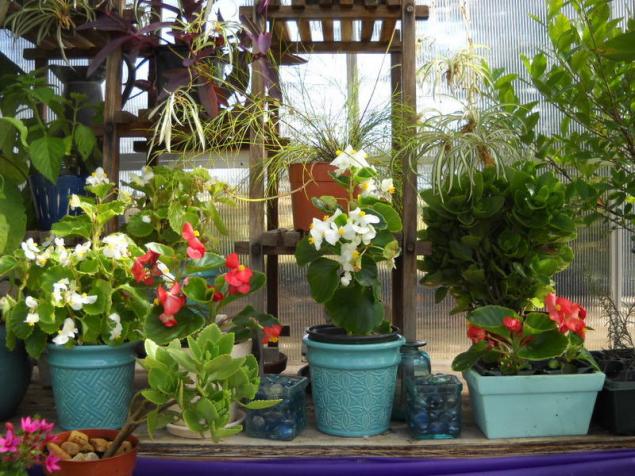
Sowing in pots
The best time for sowing the end of February – beginning of March. If you are sowing in this period, the plants will have time to get stronger is good for planting in the ground.
The pots are pre-filled nutrient earthy blend, then it should be slightly moistened! Then seeds or pellets with seeds should be placed on the top layer of soil, and sprayed from a spray. Sprinkle a substrate is not necessary! next you need over the pot to create the conditions of a greenhouse, simply cover the pot with plastic wrap, or glass. Now just have to wait until the seed would not germinate.
For successful germination the seeds need a temperature of over 22°C. Periodically teplichku should be opened and aired, this is to ensure that the seeds would not plesnevami.
The first seedlings should appear after 15-20 days. When the seedlings will produce 2-3 true leaves, they are ready for the first pick. But this pick must be made very carefully, since young plants are very fragile and delicate.
After the pick, the air temperature should be slightly lowered to 18°C, and a little less water. When the threat of a late frost, the plants can be transplanted into the ground.
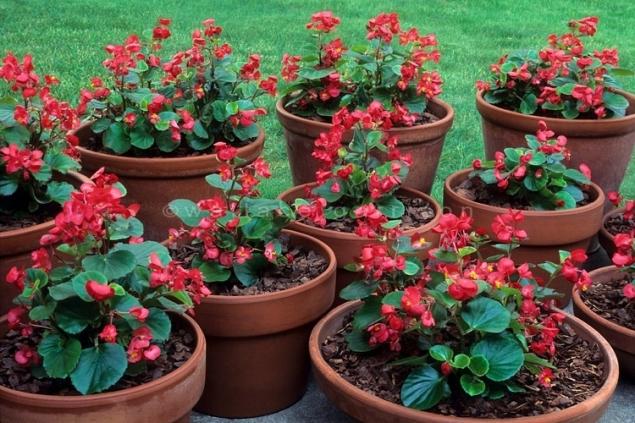
Vale of eternal blossoms begonia propagation by cuttings
Begonia can be propagated also by cuttings. To obtain cuttings of the plant in early March cut, quite short.
This crop is considered to be healing and all that is cut off can be discarded as during the winter, the plant is usually extracted because of the lack of light, and the cuttings will turn weak.
After pruning the Bush begin to fertilize and water, importantly to do it regularly. After some time, the Bush will produce strong young shoots. Here it will be cuttings. Shoots are cut and immediately planted in the nursery, often the ovary is a common place pot.
Also useful: Annuals for Your garden, blooming all summer
The French kitchen garden: the unique charm of your area
The soil interfere with 1/1 with sand. After a time, when the bushes will be new leaves of plants can be considered established. Now they can be transplanted into the soil in a permanent place. The main thing in this germination to observe temperature in the range 20 to 22°C. Transplant into the ground should be carried out when the threat of late spring frosts.published
P. S. And remember, only by changing their consumption — together we change the world! ©
Source: www.art-pen.ru/
Begonia Vale of eternal blossoms one of the most undemanding species and can be grown as on the windowsill and in the garden. And named it the Vale of eternal blossoms due to continue flowering profusely, and in the garden is flowering lasts until the onset of cold weather.

Description of the plant
Vale of eternal blossoms begonia is a low compact plant with a height of only 15 to 20 cm. the plant has succulent fleshy stems and large rounded leaves extended, devoid of symmetry. Leaf color may be different from light green to red-brown.
The flowers of this plant, not as attractive as the leaves, they are quite small and are assembled in branched inflorescences. Their color can be quite varied, there are plants with white, pink, red, purple, orange and bright crimson flowers. Extremely ornamental flowering begonias are planted in the garden they resemble a speckled and colorful carpet that is pleasing to the eye to the cold weather.
Seeds from the Vale of eternal blossoms begonias are quite small, usually brown.
Where and how to use
Quite often you can find the Vale of eternal blossoms begonia flower beds, it is planted as in group plantings, and a continuous carpet of using plants with different color leaves and flowers.
In addition, this type of begonias can be planted in outdoor pots or in pots on the balcony and the room.
In group plantings begonias are planted in the foreground, because of her short stature and great tillering. There are cases that the compositions and the design of the site is a plant used as a groundcover, in this case it is perfectly combined with roses or lilies.
As the plant is well tolerated partial shade conditions, it can be planted in the shade of the trees creating a bright backdrop for the garden, the plant also can be planted directly around the trees themselves.
Conditions for successful cultivation
Begonia Vale of eternal blossoms special care is not required, but if you want these plants grew well and bloomed profusely, you will have to follow certain rules of agricultural technology.
The location and placement in the garden or flower bed
Ideal for planting this plant is a Sunny area, but it is desirable that in the midday heat of the plant was protected from direct sunlight. As suitable conditions partial shade, completely in the shade begonia plant is not necessary, since due to the lack of light can start to elongate the stems and the flowers will be pale and expressionless.

The location on the windowsill
For begonias indoors suitable Sunny window sill, but again, the plant should be pritenyat. In terms of the sill to direct sunlight can leave on the leaves burns.
Requirements to the soil
Like most plants for begonias need a loose, waterproof and breathable fertile soil. Also pay attention to the acidity of the soil for begonias it must be slightly acidic. If you plant the plant in soil rich in alkali, the immune system of the plant is reduced and it is possible to lose chlorosis or other diseases and pests.
Watering
Plants are demanding in terms of watering, especially areas with dry and hot summers. Watering is made in the morning or evening preferably soft, water pooled. Pour the plant should not be, otherwise they can hit various types of rot.
Dressing
For good growth and abundant flowering begonia once every two to three weeks to feed. For dressing you can use any organic and mineral fertilizers for flowering plants.
Plants in winter
In the garden of the Vale of eternal blossoms begonia is grown as an annual plant. If you want to grow for several years, before the onset of cold weather to repot the plants in pots and indoors. The well-chosen sill with sufficient care the plants will continue its development and flowering.
The propagation of begonias
Begonia propagated by growing it from seed or cuttings.
Begonia Vale of eternal blossoms, growing from seed
If you need a large area to plant begonias, you should use seed multiplication. The seeds of this plant are very small, and on sale quite often they are sold in granules, to facilitate the seeding process.

Sowing in pots
The best time for sowing the end of February – beginning of March. If you are sowing in this period, the plants will have time to get stronger is good for planting in the ground.
The pots are pre-filled nutrient earthy blend, then it should be slightly moistened! Then seeds or pellets with seeds should be placed on the top layer of soil, and sprayed from a spray. Sprinkle a substrate is not necessary! next you need over the pot to create the conditions of a greenhouse, simply cover the pot with plastic wrap, or glass. Now just have to wait until the seed would not germinate.
For successful germination the seeds need a temperature of over 22°C. Periodically teplichku should be opened and aired, this is to ensure that the seeds would not plesnevami.
The first seedlings should appear after 15-20 days. When the seedlings will produce 2-3 true leaves, they are ready for the first pick. But this pick must be made very carefully, since young plants are very fragile and delicate.
After the pick, the air temperature should be slightly lowered to 18°C, and a little less water. When the threat of a late frost, the plants can be transplanted into the ground.

Vale of eternal blossoms begonia propagation by cuttings
Begonia can be propagated also by cuttings. To obtain cuttings of the plant in early March cut, quite short.
This crop is considered to be healing and all that is cut off can be discarded as during the winter, the plant is usually extracted because of the lack of light, and the cuttings will turn weak.
After pruning the Bush begin to fertilize and water, importantly to do it regularly. After some time, the Bush will produce strong young shoots. Here it will be cuttings. Shoots are cut and immediately planted in the nursery, often the ovary is a common place pot.
Also useful: Annuals for Your garden, blooming all summer
The French kitchen garden: the unique charm of your area
The soil interfere with 1/1 with sand. After a time, when the bushes will be new leaves of plants can be considered established. Now they can be transplanted into the soil in a permanent place. The main thing in this germination to observe temperature in the range 20 to 22°C. Transplant into the ground should be carried out when the threat of late spring frosts.published
P. S. And remember, only by changing their consumption — together we change the world! ©
Source: www.art-pen.ru/
Do I need to tape up the webcam on laptops
Where to go in summer: top 12 overseas places under the sun


